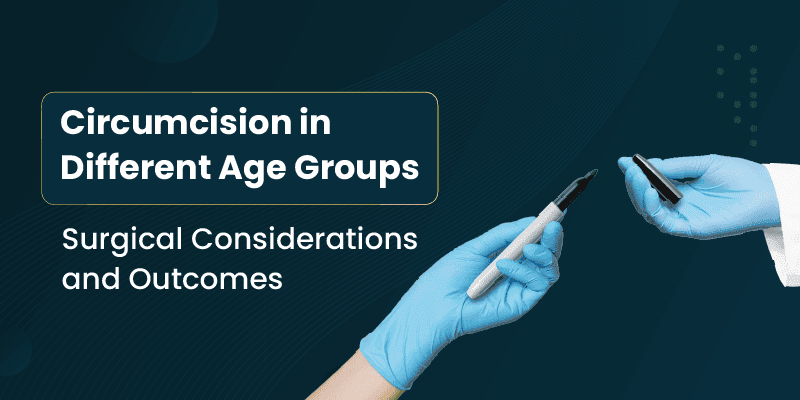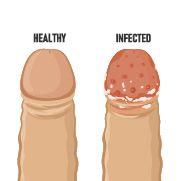Circumcision In Different Age Groups: Surgical Considerations And Outcomes
In This Article
Circumcision In Different Age Groups: Surgical Considerations And Outcomes
Alaka
Updated on March 15, 2024
Medically verified by Dr. Arya
Fact checked by Dr. Pournami

Urology
6 min read
Do you know about the circumcision process in different age groups? Curious about its considerations and outcomes?
Are you someone who is looking for circumcision options for your infant? Or an adult considering circumcision? Mykare Health has got you covered!
In this blog, we will help you understand the basics of infant, adolescent, and adult circumcisions. Join us in uncovering the circumcision methods performed in different age groups.
Importance Of Age Appropriate Circumcision
The surgical process, recovery, and results can vary depending on the age at which a person gets circumcised.
People of different age groups can have different results and consideration in circumcision. It can vary for infants, adolescents, and adults.
Deciding the appropriate age for circumcision can depend on various factors. It can include pain tolerance, healing capacity, and the ability to provide informed consent.
By exploring circumcision in different age groups, you will understand each of them better. You will have a better idea about the surgical considerations and outcomes.
Infant Circumcision
In infant circumcision or neonatal circumcision, infants are circumcised within a few days or weeks after birth.
It is one of the common procedures performed worldwide. It is because of religious or cultural traditions. It is also performed due to medical issues.
What happens during this?
- The surgical procedure of infant circumcision is removing the penis’ foreskin.
- It can be done using certain methods. Gomco clamp, mogen clamp, and plastibell device are the techniques used in the procedure.
- During the procedure, the infant will be given anesthesia. The procedure usually takes 15 minutes.
- Expert surgeons do the procedure efficiently with minimal complications. It is up to the parents to choose which method to be used on the child.
- It is also an important factor that parents have a thorough idea about the circumcision their child undergoes.
- They should consider the risks and benefits of the procedure as well. They are part of the outcomes of circumcision.
- Here are some of the potential risks and benefits of infant circumcision.
Benefits:
- Lower risk of urinary tract infections (UTIs)
- Lower risk of sexually transmitted diseases (STDs)
- Lower risk of penile cancer
- Lower risk of penile infections
- Better hygiene
Risks:
- Bleeding
- Swelling
- Surgical error
- Pain and discomfort
- Yellow discharge
Some benefits and risks can be common in circumcision of all age groups. Lower risk of UTIs and STDs are the most common ones. There are chances of bleeding in most of the cases as well.
Adolescent Circumcision
Adolescent circumcision involves the procedure of removing foreskin from the penis during teenage.
Adolescent circumcision can be due to traditional, medical, or personal reasons. It can include the need for better hygiene as well.
Unlike infant circumcision, the person undergoing the surgery will have an idea in this case. So, it is important to consider their opinions. They should also provide informed consent.
What happens during this?
- The surgical procedure for adolescent circumcision is like that of infant circumcision.
- Anesthesia will be given. It is followed by a method according to the individual’s and surgeon’s choice.
- It is important that the person, parents, and doctors have open communication. It helps doctors to know their preferences. Post surgery care is equally important.
- The doctor will provide instructions based on the same.
- Teenagers may want to undergo circumcision for several reasons. It can be because of medical reasons, cultural reasons, or by personal choice.
- Teenage circumcision is also suggested by doctors as a solution for phimosis.
Benefits:
- Prevention from certain medical conditions
- Cosmetic appearance
- Reduced body image concerns
- Lower risk of STDs and UTIs
Risks:
- Bleeding and swelling
- Injury
- Unsatisfactory cosmetic results
- Ethical issues
Adult Circumcision
Adult circumcision is the same process of foreskin removal.
But the procedure in adults is larger than that of infants. Adults choose to get circumcised for certain reasons.
It can be due to medical, social, or religious reasons.
 6 min read
6 min readWhat is Stapler Circumcision - Everything You Need to Know
 8 min read
8 min readIs Circumcision Good or Bad - Here's How to Find Out
 8 min read
8 min readCircumcision - Scientific Guide to All Your Questions
Get a Callback Now
- Adults, unlike infants or teenagers, can take part in informed decision making. They can discuss with the surgeon directly about their preferences.
- The surgical methods for adult circumcision can vary. It can be based on individual preferences.
- It can be painless and can cause slight pain according to the chosen method.
- In adult circumcision, doctors consider certain factors before finalizing an individual’s circumcision.
- The person’s medical condition, personal preferences, and penile anatomy will get considered.
- If the person has any underlying medical issues that could cause any risk, surgery cannot be done.
- For adults, local or general anesthesia may be given. It should be according to the condition.
- Extra care during the procedure is needed if the circumcision is due to medical reasons.
- Pain management is also better in adults. But the recovery period will depend on the aftercare each individual does.
Benefits:
- Lower risk of STDs and UTIs
- Lower chance of cervical cancer for partners
- Lower risk of penile conditions such as phimosis and balanitis
- Lower risk of developing penile cancer
Risks
- Pain and irritation
- Bleeding
- Infection
- Reaction to anesthesia
- Meatitis
Infant Circumcision vs. Adult Circumcision
| Aspect* | **Infant Circumcision** | *Adult Circumcision |
| ---- | ----- | ---- |
| Age Range | Typically performed within the first few days to weeks of life. | Generally performed on an individual's own decision based on personal preference, often during adulthood.
| Procedure Duration | Short procedure, takes less time due to smaller anatomy. | Procedure duration may be longer due to larger anatomy and potential complexities.
| Anesthesia | Local anesthesia is commonly used, sometimes combined with other methods. | Local or general anesthesia may be used, depending on the individual's preference.
| Healing Time | Faster healing due to young age and smaller wound size. | Healing time may be longer due to larger wound size and potential complications.
| Postoperative Pain | Generally less postoperative pain compared to adults. | Postoperative pain may be more significant due to the larger wound size.
| Complications | Lower risk of complications due to smaller size and faster healing. | Complication risk may increase with age, but overall still relatively low.
| Decision-Maker | Parents or guardians usually make the decision. | The individual typically makes the decision.
| Preventive Benefits | May provide some immediate preventive benefits. | Commonly performed for cultural, religious, or personal reasons; preventive benefits may include reduced risk of certain infections.
The surgical process, recovery, and results can vary depending on the age. People of different age groups can have different results and consideration in circumcision.
Infant circumcision is done within a few days or weeks after birth. It is one of the common procedures performed. Gomco clamp, mogen clamp, and plastibell device are the techniques used. It is up to the parents to choose which method to be used on the chi
Adolescent circumcision involves the procedure of removing foreskin from the penis during teenage. Teenagers should provide informed consent for the surgery.
Teenagers choose circumcision for medical reasons, cultural reasons, or by personal choice. Teenage circumcision is also suggested by doctors as a solution for phimosis.
Adult circumcision procedures are larger than infant circumcision. They can take part in informed decision making. They can discuss their preferences. The surgical methods for adult circumcision can vary. It can be based on individual preferences.
Source Links
Johns Hopkins Medicine
Chennai Circumcision Clinic



